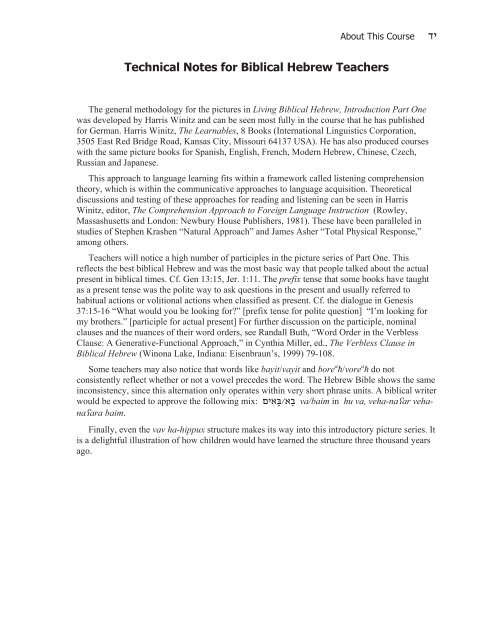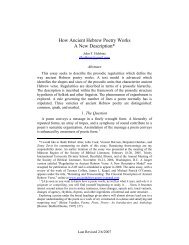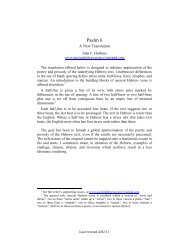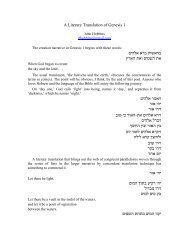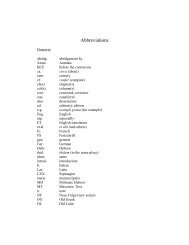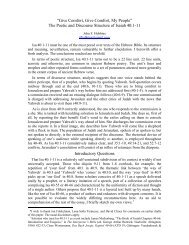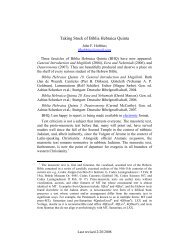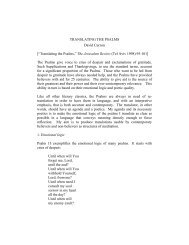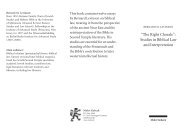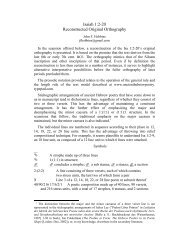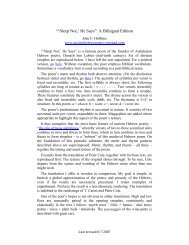About This Courseb~v, k~x, p~f change pronunciation; g, d, t remain constant; ts is used for tsadi [s with retractedtongue root], while tav/tet and kaf/qof are the same.How much <strong>Hebrew</strong> does one learn in the picture volume?The pictures in Part One introduce a student to about 700 different forms in varying syntacticcontexts based on 250 different vocabulary items. In addition, a student learns the alphabet andhow to spell the forms. This is accomplished in approximately 25–50 study hours. In context,students recognize and understand 80-95% of the material at this stage of learning.At the end of Part Two, students are able to read the book of Jonah with understanding.Because of the built-in repetition, exceptional students have been able to read these books outloud and correctly from unvocalized texts. Part Two requires 120-240 study hours.How does this course relate to modern <strong>Hebrew</strong>?First of all, this course is sufficient in itself and does not depend on any previous study of eithermodern <strong>Hebrew</strong> or biblical <strong>Hebrew</strong>.Additionally, this course harmonizes with modern <strong>Hebrew</strong> programs. A person may profitablystudy modern <strong>Hebrew</strong> concurrently with, after, or even before this course.The fluency, listening and reading skills that are developed in this course immediatelyreinforce the related skills in modern <strong>Hebrew</strong> because of the special way in which this biblical<strong>Hebrew</strong> course is taught. This course will make a direct and positive contribution to anyone whowishes to continue their <strong>Hebrew</strong> studies in any of the dialects.When does one learn grammar and syntax?Immediately from picture lesson one the student begins to learn grammar patterns and syntax,but without discussion. Learning grammar takes place directly in context. After the picturelessons and learning the alphabet, students should slowly study and observe the changes in thewords in the reading lessons.Discussions about grammar and syntax have a preview section at the end of Part One and theybegin systematically in Part Two. All the chapters of Part Two contain grammar notesinterspersed with the drills and annotated readings. By the end of the second part, the basic<strong>Biblical</strong> grammar forms and irregularities are summarized.An additional advantage of this course is that the notes and written assignments develop asensitivity for the literary features, style, and textlinguistics.The pictures in Part One begin to lay a foundation for later analytical grammar in the sameway that primer paint prepares for finishing paint. As with a quality paint job, the student isencouraged to follow directions and the natural learning sequence of this program.What about people who have already started learning biblical <strong>Hebrew</strong> or already read it, is<strong>Living</strong> <strong>Biblical</strong> <strong>Hebrew</strong> for them, too?Yes, these recordings and pictures will help anyone who has never had the experience oflearning <strong>Hebrew</strong> directly through listening. It will be a new experience and a new kind oflearning, whether someone has been reading biblical <strong>Hebrew</strong> for one year or seven years.
About This Course Technical Notes for <strong>Biblical</strong> <strong>Hebrew</strong> TeachersThe general methodology for the pictures in <strong>Living</strong> <strong>Biblical</strong> <strong>Hebrew</strong>, Introduction Part Onewas developed by Harris Winitz and can be seen most fully in the course that he has publishedfor German. Harris Winitz, The Learnables, 8 Books (International Linguistics Corporation,3505 East Red Bridge Road, Kansas City, Missouri 64137 USA). He has also produced courseswith the same picture books for Spanish, English, French, Modern <strong>Hebrew</strong>, Chinese, Czech,Russian and Japanese.This approach to language learning fits within a framework called listening comprehensiontheory, which is within the communicative approaches to language acquisition. Theoreticaldiscussions and testing of these approaches for reading and listening can be seen in HarrisWinitz, editor, The Comprehension Approach to Foreign Language Instruction (Rowley,Massashusetts and London: Newbury House Publishers, 1981). These have been paralleled instudies of Stephen Krashen “Natural Approach” and James Asher “Total Physical Response,”among others.Teachers will notice a high number of participles in the picture series of Part One. Thisreflects the best biblical <strong>Hebrew</strong> and was the most basic way that people talked about the actualpresent in biblical times. Cf. Gen 13:15, Jer. 1:11. The prefix tense that some books have taughtas a present tense was the polite way to ask questions in the present and usually referred tohabitual actions or volitional actions when classified as present. Cf. the dialogue in Genesis37:15-16 “What would you be looking for?” [prefix tense for polite question] “I’m looking formy brothers.” [participle for actual present] For further discussion on the participle, nominalclauses and the nuances of their word orders, see Randall Buth, “Word Order in the VerblessClause: A Generative-Functional Approach,” in Cynthia Miller, ed., The Verbless Clause in<strong>Biblical</strong> <strong>Hebrew</strong> (Winona Lake, Indiana: Eisenbraun’s, 1999) 79-108.Some teachers may also notice that words like bayit/vayit and bore a /vore a do notconsistently reflect whether or not a vowel precedes the word. The <strong>Hebrew</strong> Bible shows the sameinconsistency, since this alternation only operates within very short phrase units. A biblical writerwould be expected to approve the following mix: / va/baim in hu va, veha-naar vehanaarabaim.Finally, even the vav ha-hippux structure makes its way into this introductory picture series. Itis a delightful illustration of how children would have learned the structure three thousand yearsago.


